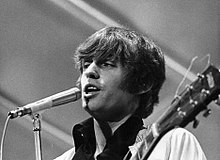Flamingo Club (Soho)
The Flamingo Club , in its final years The Pink Flamingo , colloquially The Mingo, was a club in the London borough of Soho . The club existed at 33 Wardour Street from September 1952 until the late 1960s . In the 1960s it was one of the birthplaces of British rhythm and blues . Among other things, he was known for his allnighters on weekends, when the club did not close until 6 a.m. on Saturday and Sunday. On January 14, 1963, the Rolling Stones played their first joint appearance at the Flamingo Club.
building
The club run by the brothers Rik and John Gunnell was approved for 400 guests, but in the course of its existence it has often had up to 600 guests. It was in the basement under the London whiskey A-Go-Go . There were three rows of old cinema seats in front of the small stage, and a kind of coffee bar in the background. From the area in front of the bar it was possible to see the band, audience and dance floor.
Audience and parties
At the time, the audience consisted mostly of immigrants from the Caribbean, Afro-American GIs, and some English jazz fans. In the late 1950s / early 1960s mods began to become a staple of the audience, and the after midnight program in particular was aimed primarily at this audience. Andrew Loog Oldham , manager of the Rolling Stones in the 1960s and frequent guest at Flamingo, describes the late-night audience as a mixture of Soho underground and real gangsters. The Flamingo Club stayed up until 6am on the weekend. It was one of a handful of clubs with such opening times. In the 1960s, most allnighters in London ended around midnight or two in the morning.
The club was not licensed to serve alcohol. The bar was selling cola, which had been generously spiked with scotch. While in the 1950s and early 1960s the club was considered the place to be for all of London's hashish, that changed later. In times of the mods, amphetamines and related drugs were especially common.
Musician
Many international greats of jazz, soul and rhythm and blues such as 1954 Billie Holiday and 1961 Carmen McRae played club concerts there. Music from the Caribbean such as Ska and Rocksteady were part of the program. Count Suckle had the most important sound system in London at the time and played his first gigs in the Flamingo Club in central London. The bands who performed at the Flamingo Club at the very beginning of their careers included Status Quo , The Moody Blues , Deep Purple and Led Zeppelin . Eric Clapton played here in various formations at the beginning of his career as did Rod Stewart . Unknown in England, Jimi Hendrix came to the club one night and was able to play a jam session well after midnight . Hendrix also played official concerts at the club, whose audience at the time was considered one of the toughest and most difficult to inspire on the English scene.
The members of the band Fleetwood Mac met in the club. The regular performers with numerous appearances in the club included The Moody Blues and Led Zeppelin as well as bands like Uriah Heep and The Animals . The first house band was Georgie Fame and the Blue Flames , which also placed some hits in the British charts during this time.
history
The club was originally founded as a jazz club . As discos began to establish themselves and the rhythm and blues was replaced by rock, the club began to change. Owner Jeffrey Kruger closed the shop for a while and reopened it as The Pink Flamingo. One of the first acts after the reopening was Cream , which received £ 55 for their performance. Performers at the time included Iron Maiden , Black Sabbath (£ 100, a record fee for the club) and Thin Lizzy .
In 1962 there was a knife fight between two lovers of the model Christine Keeler in the Flamingo Club , which in its aftermath triggered the Profumo affair .
After the Flamingo Club closed, the Wag Club moved into the premises. Today there is an Irish pub in the house .
The club is now the subject of numerous reports and documentations. For example, he played an important role in the BBC documentary series Soul Britannia .
Web links
- Jeffrey Kruger: Birth of the Flamingo.
- Organized Rage: A blast from the past: Rhythm, Blues and Anti Racism, Live at the Flamingo.
Remarks
- ↑ Barry J. Faulk: British rock modernism, 1967-1977. Ashgate Publishing, 2010, ISBN 978-1-4094-1190-1 , p. 81.
- ^ Murray R. Nelson: The Rolling Stones: A Musical Biography. ABC-CLIO, 2010, ISBN 978-0-313-38034-1 , p. 15.
- ^ A b c Another Nickel in the Machine: The Flamingo Club in Wardour Street and the fight between Johnny Edgecombe and 'Lucky'. Gordon
- ^ Andrew Loog Oldham: Stoned: A Memoir of London in the 1960s Macmillan, 2002 ISBN 0312270941 p. 78
- ↑ a b c d Lloyd Bradley: This is reggae music: the story of Jamaica's music Grove Press, 2001 ISBN 0802138284 p. 143
- ↑ Donald Clarke: Billie Holiday: Wishing on the Moon. Da Capo Press, 2002, ISBN 0-306-81136-7 , p. 369.
- ↑ Information at Discogs
- ↑ David Henderson: Scuse Me While I Kiss the Sky: Jimi Hendrix: Voodoo Child. Simon and Schuster, 2009, ISBN 978-0-7432-7401-2 , p. 126.
- ^ John Chilton: Who's who of British jazz. Continuum International Publishing Group, 2004, ISBN 0-8264-7234-6 , pp. 127-128.
